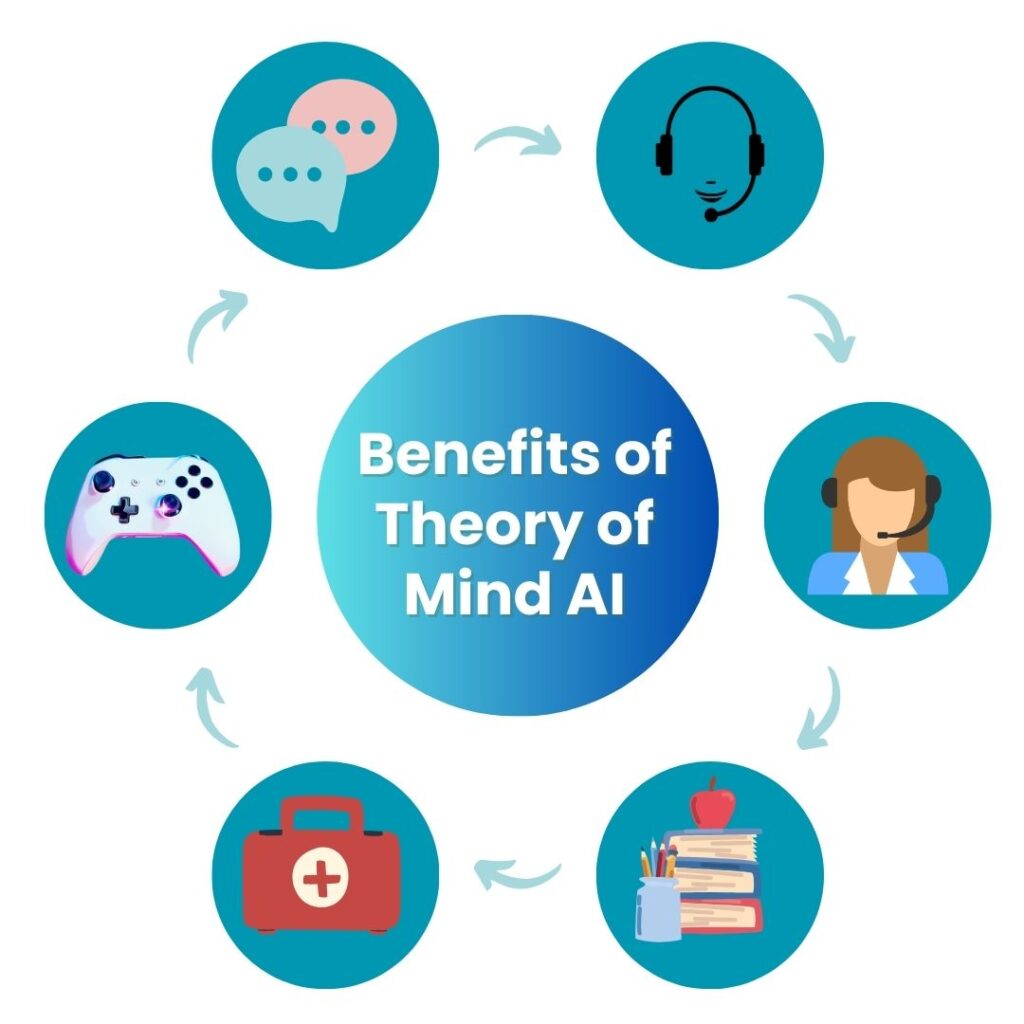Ever wondered how machines could understand our thoughts and feelings? That’s where the theory of mind AI comes in. This exciting field of artificial intelligence aims to make computers better at adapting human intentions and emotions.
The theory of mind AI is a branch of artificial intelligence that tries to give machines the ability to understand and predict human behavior, thoughts, and feelings. It’s like teaching computers to “read minds” and respond more naturally to people.
In this blog post, we’ll explore how the theory of mind AI works, why it’s important, and how it might change the way we interact with technology in the future. Get ready to discover the AI that’s learning to understand us!
Table of Contents
- What is the Theory of Mind AI?
- How Does Theory of Mind AI Work?
- Benefits of Theory of Mind AI
- Challenges in Developing Theory of Mind AI
- Real-world Examples
- The Future of Theory of Mind AI
- Conclusion
What is the Theory of Mind AI?

Theory of Mind AI is like teaching computers to be good at guessing what’s going on in our heads. Just as we can often tell what our friends are thinking or feeling. This type of AI also tries to do the same thing. It’s about making machines that can understand our thoughts, beliefs, and emotions.
Imagine having a robot helper that knows you’re tired without you saying it, or a virtual assistant that can tell when you’re confused and need to explain things differently.
That’s what Theory of Mind AI aims to do. It’s all about creating smarter, more intuitive machines that can interact with us more naturally.
How Does Theory of Mind AI Work?
Theory of Mind AI works by using a few key steps to understand people better:
- Observing: The AI watches how people act and talk.
- Collecting data: It gathers information about different behaviors and situations.
- Learning patterns: The AI finds common themes in how people think and feel.
- Making guesses: Based on what it’s learned, the AI tries to figure out what someone might be thinking or feeling.
- Adjusting: If the AI guesses wrong, it learns from its mistakes and gets better over time.
For example, imagine an AI chatbot talking to you. It might:
- Notice you’re using short answers
- Remember that short answers often mean someone is busy
- Guess that you might not have much time to chat
- Offer to give you quick, to-the-point information instead of long explanations
By following these steps, Theory of Mind AI tries to understand and respond to people in a more human-like way.
Benefits of Theory of Mind AI

Theory of Mind AI can help in many ways. Here are some key benefits:
1. Better communication:
- AI can understand what we mean, not just what we say
- Fewer misunderstandings between humans and machines
2. Smarter virtual assistants:
- Virtual assistants can guess what we need before we ask
- More helpful and natural conversations
3. Improved customer service:
- AI can sense customer emotions and respond appropriately
- Faster and more satisfying problem-solving
4. Enhanced education:
- In education, AI tutors can adapt to each student’s learning style
- More personalized and effective teaching
5. Healthcare support:
- AI can spot signs of mental health issues early
- Better support for patients with communication difficulties
6. More realistic video games:
- Characters that react more naturally to players
- More engaging and immersive gameplay
These benefits show how Theory of Mind AI can make technology work better for us in our daily lives. It’s all about creating machines that truly understand and connect with people.
Challenges in Developing Theory of Mind AI

Creating a Theory of Mind AI isn’t easy. Here are some big challenges:
1. Complex Human Behavior:
- People are hard to predict
- Emotions and thoughts change quickly
2. Cultural Differences:
- What’s normal in one culture might not be in another
- AI needs to understand many ways of thinking
3. Privacy Concerns:
- Reading Minds raises questions about personal privacy
- Need to balance helpfulness with respect for privacy
4. Ethical Issues:
- Should AI pretend to have feelings?
- How to use this technology responsibly
5. Technical Hurdles:
- Need for lots of data to train AI
- Making AI work fast enough for real-time interactions
6. Avoiding Biases:
- AI might learn unfair ideas from the data
- Must ensure AI treats everyone fairly
7. Measuring Success:
- Hard to know if AI really understands or just guesses well
- Need better ways to test the Theory of Mind in machines
These challenges show why developing a Theory of Mind AI is tricky. Scientists and engineers are working hard to solve these problems and create AI that truly understands us.
Real-world Examples
Theory of Mind AI isn’t just a cool idea – it’s already making waves in the real world. Let’s look at some exciting examples:
1. Moxie the Robot Friend

Imagine a cute little robot that can chat with kids, teach them new things, and even help them learn social skills. That’s Moxie!
This friendly bot uses the Theory of Mind AI to understand children’s emotions and respond in ways that help them grow.
2. Xiaoice

The AI Companion Over in China, millions of people chat with Xiaoice, an AI that’s designed to be a caring friend.
It remembers past conversations, picks up on emotional cues, and even writes poetry! Xiaoice shows how Theory of Mind AI can create meaningful connections.
3. Smart Cars That Get You

Some new cars are using AI to figure out if you’re tired, distracted, or upset. They might suggest taking a break if you seem sleepy, or adjusting the music if you look stressed. It’s like having a car that really understands your needs.
These examples show how the Theory of Mind AI is already changing the way we interact with technology. From helping kids learn to keep us safe on the road, these smart systems are making our lives easier and more connected.
The Future of Theory of Mind AI
The future of Theory of Mind AI looks bright and full of possibilities. We might soon see homes that understand our moods and adjust to make us comfortable.
Doctors could use AI to better help patients who have trouble communicating. In schools, AI tutors might adapt to each student’s unique way of learning.
As this technology grows, we’ll likely see more natural robots and incredibly realistic virtual reality experiences. But with these exciting changes come important questions about privacy and ethics.
One thing’s for sure – Theory of Mind AI is set to change the way we interact with machines, making our digital world more understanding and helpful.
Conclusion
In conclusion, Theory of Mind AI is an exciting field that’s making machines better at understanding us. It’s already changing how we interact with technology, from friendly robots to smarter virtual assistants.
As this technology grows, it promises to make our lives easier and more connected. While challenges exist, the future looks bright for AI that can truly understand and respond to human thoughts and feelings.

Ajay Rathod loves talking about artificial intelligence (AI). He thinks AI is super cool and wants everyone to understand it better. Ajay has been working with computers for a long time and knows a lot about AI. He wants to share his knowledge with you so you can learn too!


Truly appreciate your well-written posts. I have certainly picked up valuable insights from your page. Here is mine 81N about Cosmetics. Feel free to visit soon.